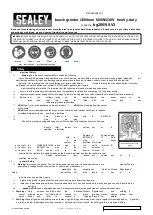
24
EngLIsh
WARNING:
We recommend the use of a residual current
device with a residual current rating of 30mA or less.
Residual Risks
In spite of the application of the relevant safety regulations
and the implementation of safety devices, certain residual risks
cannot be avoided. These are:
• Impairment of hearing.
• Risk of personal injury due to flying particles.
• Risk of burns due to accessories becoming hot
during operation.
• Risk of personal injury due to prolonged use.
SAVE THESE INSTRUCTIONS
FURTHER SAFETY INSTRUCTIONS FOR ALL
OPERATIONS
Causes and Operator Prevention
of Kickback
Kickback is a sudden reaction to a pinched or snagged rotating
wheel, backing pad, brush or any other accessory. Pinching or
snagging causes rapid stalling of the rotating accessory which
in turn causes the uncontrolled power tool to be forced in the
direction opposite of the accessory’s rotation at the point of
the binding.
For example, if an abrasive wheel is snagged or pinched by the
workpiece, the edge of the wheel that is entering into the pinch
point can dig into the surface of the material causing the wheel
to climb out or kick out. The wheel may either jump toward or
away from the operator, depending on direction of the wheel’s
movement at the point of pinching. Abrasive wheels may also
break under these conditions.
Kickback is the result of tool misuse and/or incorrect operating
procedures or conditions and can be avoided by taking proper
precautions as given below:
a )
Maintain a firm grip on the power tool and position
your body and arm to allow you to resist kickback
forces. Always use auxiliary handle, if provided, for
maximum control over kickback or torque reaction
during start up.
The operator can control torque reaction
or kickback forces, if proper precautions are taken.
b )
Use special care when working corners, sharp edges
etc. Avoid bouncing and snagging the accessory.
Corners, sharp edges or bouncing have a tendency to
snag the rotating accessory and cause loss of control
or kickback.
c )
Do not attach a saw chain woodcarving blade or
toothed saw blade.
Such blades create frequent kickback
and loss of control.
d )
Always feed the bit into the material in the same
direction as the cutting edge is exiting from the
material (which is the same direction as the chips are
thrown).
Feeding the tool in the wrong direction causes
the cutting edge of the bit to climb out of the work and
pull the tool in the direction of this feed.
e )
When using rotary files, cut off wheels, high-speed
cutters or tungsten carbide cutters, always have the
work securely clamped.
These wheels will grab if they
become slightly canted in the groove, and can kickback.
When a cut-off wheel grabs, the wheel itself usually
breaks. When a rotary file, high speed cutter or tungsten
carbide cutter grabs, it may jump from the groove and you
could lose control of the tool.
Safety Warnings Specific for Grinding and
Cutting-Off Operations
a )
Use only wheel types that are recommended for your
power tool and only for recommended applications.
For example: Do not grind with the side of a cut-off
wheel.
Abrasive cut-off wheels are intended for peripheral
grinding, side forces applied to these wheels may cause
them to shatter.
b )
For threaded abrasive cones and plugs use only
undamaged wheel mandrels with an unrelieved
shoulder flange that are of a correct size and length.
Proper mandrels will reduce the possibility of breakage.
c )
Do not "jam" a cut-off wheel or apply excessive
pressure. Do not attempt to make an excessive depth
of cut.
Overstressing the wheel increases the loading and
susceptibility to twisting or snapping of the wheel in the
cut and the possibility of kickback ort wheel breakage.
d )
Do not position your hand in line with or behind
a rotating wheel.
When the wheel, at the point of
operation, is moving away from your hand, the possible
kickback may propel the wheel and the power tool directly
at you.
e )
When wheel is pinched, snagged or when
interrupting a cut for any reason, switch off the
power tool and hold the power tool motionless until
the wheel comes to a complete stop. Never attempt
to remove the cut-off wheel from the cut while the
wheel is in motion otherwise kickback may occur.
Investigate and take corrective action to eliminate the
cause of wheel pinching or snagging.
f )
Do not restart the cutting operation in the
workpiece. Let the wheel reach full speed and
carefully re-enter the cut.
The wheel may bind, walk up
or kickback if the power tool is restarted in the workpiece.
g )
Support panels or any oversized workpiece to
minimize the risk of wheel pinching and kickback.
Large workpieces tend to sag under their own weight.
Supports must be placed under the workpiece near the line
of the cut and the edge of the workpiece on both sides of
the wheel.
h )
Use extra caution when making a "pocket cut" into
existing walls or other blind areas.
The protruding
wheel may cut gas or water pipes, electrical wiring or
objects that can cause kickback.
Summary of Contents for DWE4997
Page 1: ...DWE4997 Final page size A5 148mm x 210mm ...
Page 3: ...1 Fig A Fig B 11 12 4 5 2 3 6 1 8 10 9 7 XXXX XX XX 13 ...
Page 4: ...2 Fig D Fig C ...
Page 121: ......
Page 122: ......
Page 123: ......
















































